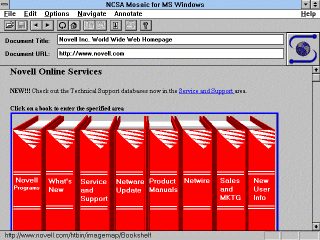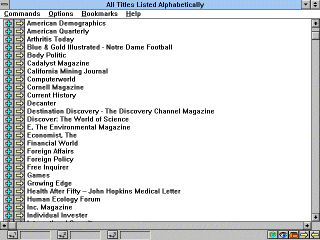
You can select a title from this online bookshelf by placing the mouse cursor on a title of interest, and clicking. This is made possible thanks to a feature first implemented with Mosaic and the NCSA HTTP server. Known as ISMAP, the feature exploits the ability of a windowing system to associate a mouse click with a spot on the screen. Mosaic communicates coordinate information to the server, so that software on the server can determine which book the user selected. The Novell server extends the metaphor to show which book has been pulled off the shelf, and offers a table of contents. The user can click on a "chapter" within a book, or can select another book to open.
The publisher O'Reilly and Associates has embarked upon use of the Internet as a medium for delivering an online magazine about the Internet. The publisher has taken advantage of the relaxation of rules concerning advertising on the Internet; the magazine is distributed free of charge, and includes online advertising. Known as GNN Magazine (for "Global Network Navigator") this periodical includes articles about the Internet by various authors. Once again, the magazine is prepared for access via World-Wide Web. Here is an example of the home page of an issue of GNN Magazine, as rendered by Mosaic:
Newspapers and magazines are also beginning to explore Internet-mediated delivery. The American Cybercasting Corporation pioneered delivery of newspapers over the Internet, starting in early 1991. Typically, ACC offers subscriptions to a newspaper on a campus-wide license. Many of the items offered are made available to locations that are not part of their normal circulation area, so that the electronic sales do not undercut paper sales. Because all major newspapers are prepared using computer-based systems, it is usually relatively easy to capture full text for delivery in flat ASCII form. Popular magazines may find campus availablity appealing because of the extension of markets, and the fact that a flat ASCII version will not compete with the illustrated print edition for current subscribers. Titles available from ACC include:
NEWS
Los Angeles Times
The Times, of London
Moscow News
Washington Post
Washington Times
USA TODAY Decisionline
The Daily Telegraph (of London)
Jerusalem Post
BUSINESS
Associated Press Financial Data
Forbes
Investor's Business Daily
California Mangement Review
ENGINEERING
Mechanical Engineering
SOCIAL SCIENCE
Brookings Review
Foreign Policy
Imprimis
Insight on the News
The National Review
New Republic
Another vendor, Counterpoint Publishing, has established a medium for Internet readers to explore current issues of a large number of popular and specialty publications. Typically you will find one or two select articles from an issue, plus the complete table of contents. Also included for each title is information on how to subscribe. Here is a sample of the titles offered by this service:

Several newspapers have established their own Gopher servers or dial-up bulletin boards as a way to supplement the print edition of the paper. One such pioneer is the News and Observer of Raleigh, North Carolina. [5] At least one newspaper, a weekly from Silicon Valley, sees the Web as the preferred mode of publication:
At least one book store has discovered the Internet as a way for
potential customers to search for books and order them
electronically. Book Stacks Unlimited accepts inbound access via
Telnet to books.com. After a brief login process, you can look for
books by author or title, browse book reviews, and order books using a
credit card.
University presses are also beginning to use the Internet as a way to
market, and in some cases, deliver their offerings. One of the
leaders is the Massachusetts Institute of Technology Press, which
offers a catalog of titles, some sample jacket covers, and other useful
information via MIT's Gopher. [6]
Many scholarly e-journals are made available at the Internet at no charge. Publishers of traditional journals are beginning to explore ways to recover subscription fees for electronic versions. In some cases, proprietary schemes are being used to allow publishers and authors to recover fees for individual subscriptions. For instance, the Online Computer Library Center (OCLC) offers the Online Journal of Current Clinical Trails via the Internet. (Access is also available over Compuserve as well as direct dial-up into OCLC.) This service requires the user to install a proprietary viewing program called Guidon, and to obtain a password associated with his or her individual subscription.